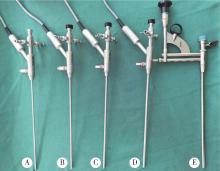北京大学学报(医学版) ›› 2024, Vol. 56 ›› Issue (4): 605-609. doi: 10.19723/j.issn.1671-167X.2024.04.010
经皮微通道-微电子肾镜-微超声探针碎石术治疗1.5~2.5 cm肾结石的疗效和安全性
- 北京大学人民医院泌尿外科,北京大学应用碎石技术研究所,北京 100044
Efficacy and safety of mini-track, mini-nephroscopy and mini-ultrasonic probe percutaneous nephrolithotomy for the treatment of 1.5-2.5 cm kidney stones
Mingrui WANG,Jun LIU*( ),Liulin XIONG,Luping YU,Hao HU,Kexin XU,Tao XU
),Liulin XIONG,Luping YU,Hao HU,Kexin XU,Tao XU
- Department of Urology, Peking University People's Hospital; The Institute of Applied Lithotripsy Technology, Peking University, Beijing 100044, China
摘要:
目的: 探讨经皮微通道-微电子肾镜-微超声探针碎石术(mini-track, mini-nephroscopy and mini-ultrasonic probe percutaneous nephrolithotomy, 3mPCNL)治疗1.5~2.5 cm肾结石的有效性和安全性。方法: 回顾性分析2023年11月至2024年1月共25例在北京大学人民医院行超声引导下3mPCNL的1.5~2.5 cm肾结石患者的围手术期资料和术后随访资料,匹配同时期内25例接受标准通道经皮肾镜碎石术(standard percutaneous nephrolithotomy, sPCNL)的1.5~2.5 cm肾结石患者,按照两组患者结石最大径差值的绝对值≤1 mm的标准进行一对一匹配,对比两种治疗方式的手术时间、肾功能改变情况、术后无石率、血红蛋白改变情况以及并发症率,进而初步分析3mPCNL治疗1.5~2.5 cm肾结石的有效性和安全性。结果: 3mPCNL组和sPCNL组患者在平均年龄、术前中位血肌酐、术前平均血红蛋白、术前平均红细胞压积、中位结石最大径和中位结石CT密度值之间的差异均无统计学意义,两组全部为单发结石。3mPCNL组患者的中位手术时间为60.0(45.0~110.0) min,与sPCNL组相比差异无统计学意义,全部为单通道手术。3mPCNL组术后平均血红蛋白为(115.3±15.5) mmol/L,与术前相比差异无统计学意义,平均血红蛋白降低值与sPCNL组相比差异无统计学意义[(9.5±2.2) mmol/L vs. (10.1±1.9) mmol/L]。3mPCNL组术后平均红细胞压积为(28.0±5.2)%,与术前相比差异有统计学意义(t=2.414,P=0.020),平均红细胞压积降低值与sPCNL组相比差异无统计学意义(2.3% vs. 2.7%)。3mPCNL组术后中位血肌酐为74.0(51.0~118.0) μmol/L,与术前相比差异有统计学意义(Z=-2.980,P=0.005)。3mPCNL组和sPCNL组术后无石率分别为96.0%和97.3%,术后平均住院时间分别为(4.3±1.4) d和(5.5±2.0) d,差异有统计学意义(t=0.192, P=0.025)。1例sPCNL组患者拔除肾造瘘管后出现大量出血,行选择性肾动脉栓塞治疗后好转;1例3mPCNL组患者出现轻度肾周血肿,行保守治疗后好转,其余患者均未见并发症。结论: 3mPCNL治疗1.5~2.5 cm肾结石可以达到与sPCNL相当的有效率,可以在较短的手术时间内获得理想的术后无石率,且手术相关并发症率较低。
中图分类号:
- R692.4
| 1 | Ganpule AP , Vijayakumar M , Malpani A , et al. Percutaneous nephrolithotomy (PCNL) a critical review[J]. Int J Surg, 2016, 36 (Pt D): 660- 664. |
| 2 |
Kyriazis I , Panagopoulos V , Kallidonis P , et al. Complications in percutaneous nephrolithotomy[J]. World J Urol, 2015, 33 (8): 1069- 1077.
doi: 10.1007/s00345-014-1400-8 |
| 3 |
Zhu W , Liu Y , Liu L , et al. Minimally invasive versus standard percutaneous nephrolithotomy: A meta-analysis[J]. Urolithiasis, 2015, 43 (6): 563- 570.
doi: 10.1007/s00240-015-0808-y |
| 4 |
Hou J , Xu F , Du H , et al. Efficacy and safety of the surgical treatments for lower calyceal stones: A systematic review and network meta-analysis[J]. Int J Surg, 2023, 109 (3): 383- 388.
doi: 10.1097/JS9.0000000000000062 |
| 5 | Kallidonis P , Tsaturyan A , Lattarulo M , et al. Minimally invasive percutaneous nephrolithotomy (PCNL): Techniques and outcomes[J]. Turk J Urol, 2020, 46 (Supp.1): S58- S63. |
| 6 | Ozdedeli K , Cek M . Residual fragments after percutaneous nephrolithotomy[J]. Balkan Med J, 2012, 9 (3): 230- 235. |
| 7 |
Singh P , Harris PC , Sas DJ , et al. The genetics of kidney stone disease and nephrocalcinosis[J]. Nat Rev Nephrol, 2022, 18 (4): 224- 240.
doi: 10.1038/s41581-021-00513-4 |
| 8 | Wang W , Fan J , Huang G , et al. Prevalence of kidney stones in mainland China: A systematic review[J]. Sci Rep, 2017, 31 (7): 41630. |
| 9 | Setthawong V , Srisubat A , Potisat S , et al. Extracorporeal shock wave lithotripsy (ESWL) versus percutaneous nephrolithotomy (PCNL) or retrograde intrarenal surgery (RIRS) for kidney stones[J]. Cochrane Database Syst Rev, 2023, 8 (8): CD007044. |
| 10 |
Dorantes-Carrillo LA , Basulto-Martínez M , Suárez-Ibarrola R , et al. Retrograde intrarenal surgery versus miniaturized percutaneous nephrolithotomy for kidney stones >1 cm: A systematic review and meta-analysis of randomized trials[J]. Eur Urol Focus, 2022, 8 (1): 259- 270.
doi: 10.1016/j.euf.2021.02.008 |
| 11 | Lai D , He Y , Li X , et al. RIRS with vacuum-assisted ureteral access sheath versus MPCNL for the treatment of 2-4 cm renal stone[J]. Biomed Res Int, 2020, 2020, 8052013. |
| 12 |
Giannakopoulos S , Giannopoulos S , Gardikis S , et al. Second-look flexible nephroscopy combined with holmium: Yttrium-aluminum-garnet laser lithotripsy under local anesthesia: A prospective study[J]. Urology, 2017, 99, 27- 32.
doi: 10.1016/j.urology.2016.06.074 |
| 13 |
Pan J , Chen Q , Xue W , et al. RIRS versus mPCNL for single renal stone of 2-3 cm: Clinical outcome and cost-effective analysis in Chinese medical setting[J]. Urolithiasis, 2013, 41 (1): 73- 78.
doi: 10.1007/s00240-012-0533-8 |
| 14 | Grosso AA , Sessa F , Campi R , et al. Intraoperative and postope-rative surgical complications after ureteroscopy, retrograde intrarenal surgery, and percutaneous nephrolithotomy: A systematic review[J]. Minerva Urol Nephrol, 2021, 73 (3): 309- 332. |
| 15 |
Mishra DK , Agrawal MS . Use of a novel flexible mini-nephroscope in minimally invasive percutaneous nephrolithotomy[J]. Urology, 2017, 103, 59- 62.
doi: 10.1016/j.urology.2017.01.009 |
| 16 |
Thakur A , Sharma AP , Devana SK , et al. Does miniaturization actually decrease bleeding after percutaneous nephrolithotomy? A single-center randomized trial[J]. J Endourol, 2021, 35 (4): 451- 456.
doi: 10.1089/end.2020.0533 |
| 17 | Hao Y , Shen X , Han D , et al. Tubeless PCNL versus standard PCNL for the treatment of upper urinary tract stones: A propensity score matching analysis[J]. Int Urol Nephrol, 2024, 56 (4): 1281- 1288. |
| 18 |
Xun Y , Wang Q , Hu H , et al. Tubeless versus standard percutaneous nephrolithotomy: An update meta-analysis[J]. BMC Urol, 2017, 17 (1): 102.
doi: 10.1186/s12894-017-0295-2 |
| [1] | 郑生旗,花天池,殷桂草,张伟,姚曳,李一帆. 甘油三酯葡萄糖指数与男性肾结石风险的关联[J]. 北京大学学报(医学版), 2024, 56(4): 610-616. |
| [2] | 田聪,刘军,杨波,乔佳佳,黄晓波,许清泉. 经皮肾镜取石术中异常肾盂黏膜活检结果分析[J]. 北京大学学报(医学版), 2023, 55(5): 948-952. |
| [3] | 王昱,张慧敏,邓雪蓉,刘伟伟,陈璐,赵宁,张晓慧,宋志博,耿研,季兰岚,王玉,张卓莉. 尿枸橼酸定量检测在原发性痛风患者肾结石诊断中的应用价值[J]. 北京大学学报(医学版), 2022, 54(6): 1134-1140. |
| [4] | 安立哲,熊六林,陈亮,王焕瑞,陈伟男,黄晓波. 腹腔镜肾盂成形术联合肾盂镜超声碎石取石术治疗肾盂输尿管连接部梗阻合并肾结石[J]. 北京大学学报(医学版), 2022, 54(4): 746-750. |
| [5] | 王明瑞,王起,胡浩,赖金惠,贺永新,熊杰,刘献辉,刘士军,许克新,徐涛. 标准通道经皮肾镜取石术治疗孤立肾肾结石的长期安全性和有效性[J]. 北京大学学报(医学版), 2020, 52(4): 663-666. |
| [6] | 康宁,蒋一航,蒋宇光,吴栗洋,张际青,牛亦农,张军晖. 内镜联合超声与单纯超声引导建立皮肾通道在多镜联合术中的应用[J]. 北京大学学报(医学版), 2020, 52(4): 692-696. |
| [7] | 朱学华,杨明钰,夏海缀,何为,张智荧,刘余庆,肖春雷,马潞林,卢剑. 机器学习模型在预测肾结石输尿管软镜碎石术后早期结石清除率中的应用[J]. 北京大学学报(医学版), 2019, 51(4): 653-659. |
| [8] | 梁晨,张维宇,胡浩,王起,方志伟,许克新. 膀胱扩大术两种不同术式的疗效及并发症比较[J]. 北京大学学报(医学版), 2019, 51(2): 293-297. |
| [9] | 谌诚,张博,韩文科,林健,王刚,张晓春,宋毅,赵峥,张中元,金杰,虞巍. 超声造影技术引导下经皮肾穿刺应用于经皮肾镜取石术的单中心初步经验[J]. 北京大学学报(医学版), 2017, 49(6): 1071-1075. |
| [10] | 王少刚, 余虓. 经皮肾镜碎石术——日间手术新探索[J]. 北京大学学报(医学版), 2017, 49(5): 753-755. |
| [11] | 叶雄俊,钟文龙,熊六林,马凯,徐涛,黄晓波,王晓峰. 后腹腔镜肾脂肪囊外肾蒂淋巴管结扎术治疗乳糜尿的疗效分析[J]. 北京大学学报(医学版), 2016, 48(4): 618-621. |
| [12] | 刘可, 肖春雷, 刘余庆, 郝一昌, 张树栋, 田雨, 马潞林. 输尿管软镜下钬激光憩室颈部切开及碎石治疗微小出口肾盏憩室结石[J]. 北京大学学报(医学版), 2015, 47(4): 618-621. |
| [13] | 杨恺惟, 张崔建, 李学松, 何志嵩, 周利群. 小肾癌的临床病理特征:单中心1 276例经验总结[J]. 北京大学学报(医学版), 2014, 46(5): 790-793. |
| [14] | 杨波, 胡卫国, 胡浩, 陈亮, 李建兴, 王晓峰. 逆行肾内手术治疗肾结石失败的原因分析及其对策[J]. 北京大学学报(医学版), 2014, 46(5): 794-797. |
| [15] | 王澍, 施永康, 黄晓波, 马凯, 许清泉, 熊六林, 李建兴, 王晓峰. 上尿路结石合并感染的细菌培养及药物敏感性分析[J]. 北京大学学报(医学版), 2014, 46(5): 798-801. |
|
||


